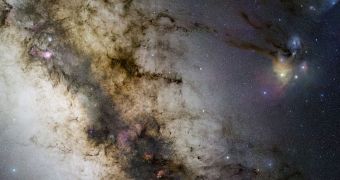In a series of recent observations, investigators managed to determine the existence of a flowing cloud of cosmic dust in the Omega Nebula. The cloud, dubbed M17 SWex, is currently forming stars, but has not yet began igniting massive, O-type stars, experts say.
O stars are the most massive stars in the Universe, and they are the hallmark of a truly developed stellar nursery. However, production of such cosmic objects only starts after a nebula begins to create smaller stars, about the size of the Sun.
After some time of frantic stellar formation, it begins churning up the massive objects. At this time, data collected with the NASA Spitzer Space Telescope indicate that this process has not yet started.
The stellar nursery was discovered in the Omega Nebula, which is also known as Messier 17 (M17) or NGC 6618. The structure was discovered by Philippe Loys de Chéseaux in 1745, hiding in the constellation Sagittarius.
“We believe we've managed to observe this dark cloud in a very early phase of star formation before its most massive stars have ignited,” explains Matthew Povich, who is an astronomer at the Pennsylvania State University.
He also holds an appointment as a postdoctoral fellow at the university, and is the lead author of a new study detailing the finding. The work was published in a recent issue of The Astrophysical Journal Letters, Daily Galaxy reports.
The absence of O stars (young, blue and very massive) from the mix immediately caught the attention of astronomers. The contrast with the rest of M17, where O stars can be found in abundance, is stark.
“Most of the stars we've detected are relatively bright. So we predict the actual number of stars forming in M17 SWex is over 10,000, since the fainter stars cannot be detected with the current observations,” Povich explains.
However, in about a million years or so, experts expect to see the massive dust cloud begin to churn up O stars in large numbers. At this point, this is not really possible due to the cloud's young age.
“The time-sequence of star formation proceeds in the same direction that a spiral arm crosses the M17 cloud complex,” the Penn State astronomer explains.
“The M17 region brings to mind images of other spiral galaxies where the leading edges of the arms appear blue, with young O stars, but the trailing edges are still dark, with obscuring dust like in M17 Swex,” he concludes.

 14 DAY TRIAL //
14 DAY TRIAL //